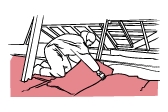
Your roof is extremely important when it comes to insulation. Not only does the sun beat down on it all day, but it also helps prevent warmth from escaping in winter. Find out how to insulate your roof.

Why is roof insulation important?
Australia is a land of many climates and, depending on where you live, you’re likely to experience a range of different weather patterns throughout the year. Long spells of very cold and very hot weather are common in Australia, which can make regulating the temperature in your home troublesome and costly. In the cold weather, up to 25% to 35% of the heat in the home is lost through the ceiling, and in summer the same proportion of heat gain occurs through the roof.
In addition to your walls, windows, doors, floor and heat loss through draughts, this is where the vast majority of temperature fluctuation happens. Having a well-insulated roof space will not only save you significant amounts on heating and cooling costs, but it will also provide a more pleasant and natural living environment. Depending on where you live, ventilation in your ceiling cavity can also make a significant difference to how comfortable your home is throughout the seasons.
What sorts of insulation are normally used in roof cavities?
Probably the most common insulation type associated with ceilings is some form of batt – be it glass wool, rock wool or some other variant like natural wool. This isn’t to say that other types can’t be used; cellulose fibre for instance is popular too, although batts are easily cut and shaped to fit so that they don’t interfere with things like downlight fittings.
Reflective foil is often used in combination with another type of bulk insulation in the ceiling to help further reduce heat by reflecting radiated heat. If you live in a tropical part of Australia up north, chances are that your home will be better served only using reflective foil.
Natural insulative properties of different roofing materials
Certain roofing materials offer more in the way of natural insulation than others. Metal roofing, like corrugated steel or aluminium is a good heat conductor, and therefore a poor insulator. It also offers very little in the way of soundproofing. Metal roofing is commonly installed over what’s known as a ‘roofing blanket’ – a layer of glass or mineral wool, sometimes coupled with a foil layer, to help reduce the amount of heat and noise that’s transmitted directly through the roof.
Ceramic, concrete and stone tiles perform better in terms of the insulation they provide, but they still have a high thermal mass, meaning that they will absorb heat and can continue to emit warmth into your ceiling cavity long after the sun has gone down. As an example, a dark-coloured concrete tile roof will absorb and hold far more heat than a lightly coloured PVC roof.
Roof ventilation
Because the roof plays such a vital role in the heating and cooling of your home, it’s well worth being able to regulate its temperature as well as that of your home. In summer, the temperature in your ceiling space can soar if it’s trapping heat – much higher than the air temperature outdoors. In winter, the heat inside your home will naturally try and rise through the ceiling. This is where controlled ventilation comes in and the more heat you roof holds, the more of it you’re going to need.
Ventilation can be achieved in a few different ways; simple strategic openings in the roof space, screened off with wire or mesh to stop dust and pests will allow airflow if it’s placed correctly. It’s also possible to get very serious about roof ventilation and install controlled vents which redirect heated air back into your house when necessary and expel it faster when it’s not wanted. This level of control over your ceiling temperature can dramatically increase how effective your insulation is, and save you a bundle in electrical heating and cooling costs.
Cool roofs
A cool roof is a roof that has been painted or clad with materials that both reflect and release solar energy. While some roof cladding materials will absorb a lot of solar energy (i.e. heat from the sun), a house with a cool roof absorbs only very small amounts of heat. White vinyl is widely regarded as one of the best materials for cool roofs, however there are a variety of solar reflective paints and coatings to choose from.
Studies have shown that on average, the temperature of a roof with a black surface can be reduced by 15°C by having it retrofitted with a cool roof surface. Other studies suggest that installing a cool roof can even reduce energy consumption by between 10% and 50% – depending on how heavily you run your air conditioners, of course.
Cool roofs are best suited to tropical and subtropical climates, where they replace bulk insulation.
Green roofs
Another interesting (but uncommon) option is the ‘green roof’. This type of roof is converted to a space for growing plants, which help to absorb solar energy as well as insulating the inside of your home. Green roofs are made up of layers – at the base there will be an insulation layer, then a waterproof membrane, then a drainage layer, followed by the soil, then a mat to prevent the soil from blowing away and finally, the plants themselves. Depending on the depth of the soil, the plants can be anything from moss and grass, to trees and shrubs.
Green roofs can be constructed to suit most climates. Due to the considerable weight they add to the roof, it’s important that they’re accounted for from the design stages to ensure that the roof and walls have the necessary load bearing capacity though.





